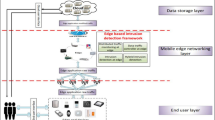Abstract
The Internet of Things continues to grow in size, connection, and applicability. Just like other new technologies, this ecosystem affects every area of our daily existence (Kafle et al. in IEEE Commun Mag 54:43–49, 2016). Despite the many advantages of the Internet of Things (IoT), the importance of securing its expanded attack surface has never been higher. There has been a recent increase in reports of botnet threats moving into the Internet of Things (IoT) environment. As a result, finding effective methods to secure IoT systems is a critical and challenging area of study. Potentially useful alternatives include methods based on machine learning, which can identify suspicious activities and even uncover network attacks. Simply relying on one machine learning strategy may lead to inaccuracies in data collection, processing, and representation if applied in practice. This research uses stacked ensemble learning to detect attacks better than conventional learning, which uses one algorithm for intruder detection (ID). To evaluate how well the stacked ensemble system performs in comparison to other common machine learning algorithms like Decision Tree (DT), random forest (RF), Naive Bayes (NB), and support vector machine (SVM), the BoT-IoT benchmark dataset has been used. Based on the findings of the experiments, stacked ensemble learning is the best method for classifying attacks currently available. Our experimental outcomes were assessed for validation data set, accuracy, precision, recall, and F1-score. Our results were competitive with best accuracy and ROC values when benchmarked against existing research.
Access this chapter
Tax calculation will be finalised at checkout
Purchases are for personal use only
Similar content being viewed by others
References
Zanella A, Bui N, Castellani A, Vangelista L, Zorzi M (2014) Internet of things for smart cities. IEEE Internet Things J 1(1):22–32
IoT bots cause massive internet outage. https://www.beyondtrust.com/blog/iot-bots-cause-october-21st-2016-massive-internet-outage/. Accessed 22 Oct 2016
Colakovič A, Hadžialić M (2018) Internet of things (IoT): a review of enabling technologies, challenges, and open research issues. Comput Netw 144:17–39
Creech G, Hu J (2014) A semantic approach to host-based intrusion detection systems using contiguous and discontiguous system call patterns. IEEE Trans Comput 63(4):807–819
Mohan R, Danda J, Hota C (2016) Attack identification framework for IoT devices. Springer, New Delhi
Hashemi TS, Ebadati OM, Kaur H (2020) Cost estimation and prediction in construction projects: a systematic review on machine learning techniques. SN Appl Sci 2:1703
Duque S, bin Omar MN (2015) Using data mining algorithms for develo** a model for intrusion detection system (IDS). Procedia Comput Sci 61:46–51
Tsai C-F, Hsu Y-F, Lin C-Y, Lin W-Y (2009) Intrusion detection by machine learning: a review. Expert Syst Appl 36(10):11994–12000
Reddy AS, Akashdeep S, Harshvardhan R, Sowmya SK (2022) Stacking deep learning and machine learning models for short-term energy consumption forecasting. Adv Eng Inform 52:101542
Krco S, Pokrič B, Carrez F (2014) Designing IoT architecture(s): a European perspective. In: 2014 IEEE World forum on internet of things (WF-IoT). IEEE, Seoul. pp 79–84
Prokhorenkova L, Gusev G, Vorobev A, Dorogush AV, Gulin A (2018) CatBoost: unbiased boosting with categorical features. In: Proceedings of the advances in neural information processing systems, Montréal, QC, Canada, 3–8 December 2018, vol 31
Ahmed E, Yaqoob I, Gani A, Imran M, Guizani M (2016) Internet-of-things-based smart environments: state of the art, taxonomy, and open research challenges. IEEE Wirel Commun 23(5):10–16
Kumar S, Vealey T, Srivastava H (2016) Security in internet of things: challenges, solutions and future directions. In: 2016 49th Hawaii International conference on system sciences (HICSS), Koloa, pp 5772–5781
Meharie M, Mengesha W, Gariy Z, Mutuku R (2021) Application of stacking ensemble machine learning algorithm in predicting the cost of highway construction projects. Eng Constr Archit Manag 29:2836–2853
Kalagotla SK, Gangashetty SV, Giridhar K (2021) A novel stacking technique for prediction of diabetes. Comput Biol Med 135:104554
Srirutchataboon G, Prasertthum S, Chuangsuwanich E, Pratanwanich PN, Ratanamahatana C (2021) Stacking ensemble learning for housing price prediction: a case study in Thailand. In: Proceedings of the 2021 13th International conference on knowledge and smart technology (KST), Bangsaen, Chonburi, Thailand, 21–24 January 2021, pp 73–77
Snoek J, Larochelle H, Adams RP (2012) Practical Bayesian optimization of machine learning algorithms. In: Proceedings of the advances in neural information processing systems, Lake Tahoe, NV, USA, 3–6 December 2012, vol 25
Lavanya K, Suresh GV (2021) An additive sparse logistic regularization method for cancer classification in microarray data. Int Arab J Inf Technol 18(2). ISSN: 1683-3198 e-ISSN: 2309-4524. https://doi.org/10.34028/iajit/18/10
Lavanya K, Harika K, Monica D, Sreshta K (2020) Additive tuning lasso (AT-Lasso): a proposed smoothing regularization technique for shop** sale price prediction. Int J Adv Sci Technol 29(5):878–886
Lavanya K, Reddy L, Reddy BE (2019) Distributed based serial regression multiple imputation for high dimensional multivariate data in multicore environment of cloud. Int J Ambient Comput Intell (IJACI) 10(2):63–79. https://doi.org/10.4018/IJACI.2019040105
Lavanya K, Reddy LSS, Eswara Reddy B (2018) Modelling of missing data imputation using additive LASSO regression model in Microsoft Azure. J Eng Appl Sci 13(Special Issue 8):6324–6334
Lavanya K, Reddy LSS, Eswara Reddy B (2019) Multivariate missing data handling with iterative Bayesian additive Lasso (IBAL) multiple imputation in multicore environment on cloud. Int J Future Revol Comput Sci Commun Eng (IJFRSCE) 5(5)
Moustafa N (2019) The Bot-IoT dataset. IEEE Dataport. https://doi.org/10.21227/r7v2-x988
Author information
Authors and Affiliations
Corresponding author
Editor information
Editors and Affiliations
Rights and permissions
Copyright information
© 2024 The Author(s), under exclusive license to Springer Nature Singapore Pte Ltd.
About this paper
Cite this paper
Rao, C.P.V.S., Bhavani, R., Indhumathi, N., Raviteja, G. (2024). EL-ID-BID: Ensemble Stacking-Based Intruder Detection in BoT-IoT Data. In: Hassanien, A.E., Castillo, O., Anand, S., Jaiswal, A. (eds) International Conference on Innovative Computing and Communications. ICICC 2023. Lecture Notes in Networks and Systems, vol 731. Springer, Singapore. https://doi.org/10.1007/978-981-99-4071-4_62
Download citation
DOI: https://doi.org/10.1007/978-981-99-4071-4_62
Published:
Publisher Name: Springer, Singapore
Print ISBN: 978-981-99-4070-7
Online ISBN: 978-981-99-4071-4
eBook Packages: EngineeringEngineering (R0)




